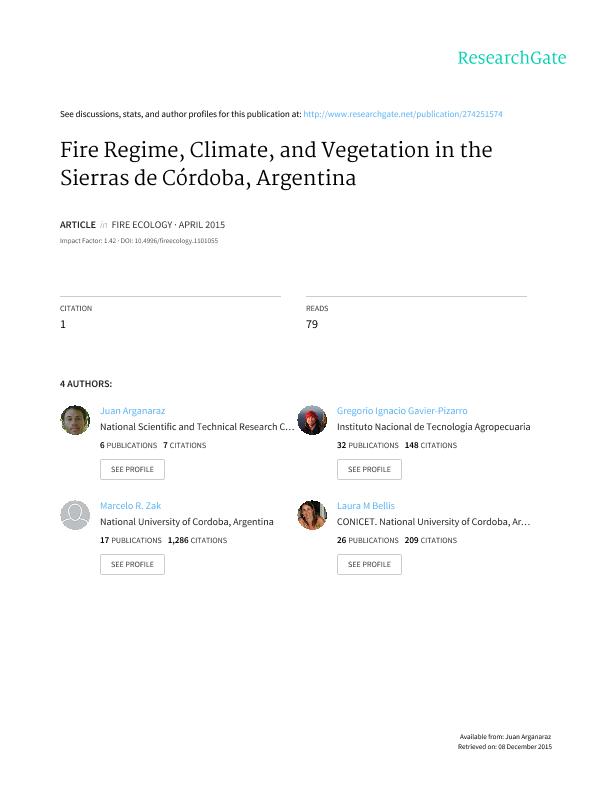Mostrar el registro sencillo del ítem
dc.contributor.author
Argañaraz, Juan Pablo

dc.contributor.author
Gavier Pizarro, Gregorio
dc.contributor.author
Zak, Marcelo Román

dc.contributor.author
Bellis, Laura Marisa

dc.date.available
2016-11-03T15:25:11Z
dc.date.issued
2015-06
dc.identifier.citation
Argañaraz, Juan Pablo; Gavier Pizarro, Gregorio; Zak, Marcelo Román; Bellis, Laura Marisa; Fire regime, climate, and vegetation in the Sierras de Córdoba, Argentina; Association for Fire Ecology; Fire Ecology; 11; 1; 6-2015; 55-73
dc.identifier.issn
1933-9747
dc.identifier.uri
http://hdl.handle.net/11336/7926
dc.description.abstract
Wildfires are a primary disturbance in the Sierras de Córdoba, Argentina,with approximately 2152000 ha burned between 1993 and 2012. However,little is known about the spatial and temporal patterns of fires and theirrelationship with climate and vegetation in this area. Such information isof great value for fire risk assessment and the development of strategies forfire management. Our main objective was to analyze fire activity in four sierranranges, assessing which weather and climate conditions were mostly relatedto fire activity, and which land cover types were mostly burned. Weused a fire database of mid-high spatial resolution and a land cover mapderived from Landsat imagery. Fire regimes were different among the differentsierran ranges. The Sierras Chicas range was the most affected byfires, with the largest number of fire events, burned area, and fire frequency.Although large fires represented 3% to 5% of fire events, they accountedfor 60% to 86% of total burned area in different sierran ranges. Sierrasof lower elevation had a winter seasonality of fires, while sierras ofhigher elevation had a winter-spring or spring fire seasonality. The number offire events was positively correlated with preceding periods that were wetterthan normal, while the burned area was mainly associated with midtermweather conditions. Fires occurred mainly in grasslands and shrublands,but the area of burned forests was important, too. Our results will be usefulto determine the times and conditions in which fire risk is highest, and also toidentify where preventive efforts should be focused.
dc.format
application/pdf
dc.language.iso
eng
dc.publisher
Association for Fire Ecology
dc.rights
info:eu-repo/semantics/openAccess
dc.rights.uri
https://creativecommons.org/licenses/by-nc-sa/2.5/ar/
dc.subject
Abams
dc.subject
Argentina
dc.subject
Chaco Serrano
dc.subject
Córdoba Province
dc.subject
Dry Forests
dc.subject
Fire Regime
dc.subject
Landsat
dc.subject.classification
Otras Ciencias de la Tierra y relacionadas con el Medio Ambiente

dc.subject.classification
Ciencias de la Tierra y relacionadas con el Medio Ambiente

dc.subject.classification
CIENCIAS NATURALES Y EXACTAS

dc.subject.classification
Ecología

dc.subject.classification
Ciencias Biológicas

dc.subject.classification
CIENCIAS NATURALES Y EXACTAS

dc.title
Fire regime, climate, and vegetation in the Sierras de Córdoba, Argentina
dc.type
info:eu-repo/semantics/article
dc.type
info:ar-repo/semantics/artículo
dc.type
info:eu-repo/semantics/publishedVersion
dc.date.updated
2016-11-02T18:15:50Z
dc.journal.volume
11
dc.journal.number
1
dc.journal.pagination
55-73
dc.journal.pais
Estados Unidos

dc.description.fil
Fil: Argañaraz, Juan Pablo. Consejo Nacional de Investigaciones Cientificas y Tecnicas. Centro Cientifico Tecnologico Cordoba. Instituto de Diversidad y Ecologia Animal; Argentina
dc.description.fil
Fil: Gavier Pizarro, Gregorio. Instituto Nacional de Tecnología Agropecuaria. Centro Nacional de Investigaciones Agropecuarias. Centro de Investigación de Recursos Naturales. Instituto de Recursos Biológicos; Argentina
dc.description.fil
Fil: Zak, Marcelo Román. Universidad Nacional de Cordoba. Facultad de Cs.exactas Fisicas y Naturales. Departamento de Diversidad Biologica y Ecologica; Argentina
dc.description.fil
Fil: Bellis, Laura Marisa. Consejo Nacional de Investigaciones Cientificas y Tecnicas. Centro Cientifico Tecnologico Cordoba. Instituto de Diversidad y Ecologia Animal; Argentina
dc.journal.title
Fire Ecology
dc.relation.alternativeid
info:eu-repo/semantics/altIdentifier/doi/http://dx.doi.org/10.4996/fireecology.1101055
dc.relation.alternativeid
info:eu-repo/semantics/altIdentifier/url/https://fireecology.springeropen.com/articles/10.4996/fireecology.1101055
Archivos asociados
